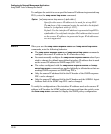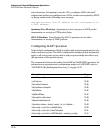
Configuring for Network Management Applications
LLDP (Link-Layer Discovery Protocol)
LLDP-MED (LLDP Media Endpoint Discovery): Provides an extension to
LLDP and is designed to support VoIP deployments.
Note LLDP-MED is an extension for LLDP, and the switch requires that LLDP be
enabled as a prerequisite to LLDP-MED operation.
An SNMP utility can progressively discover LLDP devices in a network by:
1. Reading a given device’s Neighbors table (in the Management Information
Base, or MIB) to learn about other, neighboring LLDP devices.
2. Using the information learned in step 1 to find and read the neighbor
devices’ Neighbors tables to learn about additional devices, and so on.
Also, by using show commands to access the switch’s neighbor database for
information collected by an individual switch, system administrators can learn
about other devices connected to the switch, including device type
(capability) and some configuration information. In VoIP deployments using
LLDP-MED on the switches covered in this guide, additional support unique to
VoIP applications is also available. Refer to “LLDP-MED (Media-Endpoint-
Discovery)” on page 13-53.
Terminology
Adjacent Device: Refer to “Neighbor or Neighbor Device”.
Advertisement: See LLDPDU.
Active Port: A port linked to another active device (regardless of whether
MSTP is blocking the link).
ELIN (Emergency Location Identification Number): A valid telephone
number in the North American Numbering Plan format and assigned to a
multiline telephone system operator by the appropriate authority. This
number calls a public service answering point (PSAP) and relays automatic
location identification data to the PSAP.
LLDP: Link Layer Discovery Protocol:
• Switches covered in this guide: IEEE 802.1AB
LLDP-Aware: A device that has LLDP in its operating code, regardless of
whether LLDP is enabled or disabled.
LLDP Device: A switch, server, router, or other device running LLDP.
13-35


















